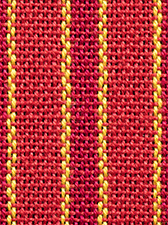Stripes and Gene Davis
Marcy Petrini
February, 2018
In the last blog we talked about warp stripes, but we can add weft stripes, too. The disadvantage is that the weft has to be changed often and there are those pesky tails to deal with. If the cloth is to be used in a garment where the edges don’t show, we can just leave them. Scottish tartans are woven that way if they will be made into kilts or other garments; the fabric is usually wool which is slightly fulled, locking in the ends anyway. The thinner the weft, the less likely is the build-up of extra tails at the edge. We can also use a technique tapestry: tapering the tail by un-plying and making each ply a slightly different length before tucking in the shed.
The advantage of weft stripes is that, if we don’t like a fabric, we can add a bit of pizazz with weft stripes. Of course weft stripes can be planned. Acadian textiles use colored cottons to their best advantages in weaving the weft stripes.
And horizontal wefts are needed to make plaids; this warp striped fabric

Can become this plaid:

When planning stripes, the conventional wisdom is to use contrasting colors – whether in hue, or value or saturation, or some combination of those – and to use the Fibonacci series for pleasing proportions. Originally described by the Italian mathematician Leonardo Fibonacci, it is a sequence where each digit is obtained by adding the previous two, after starting with 1 and 2:
1, 1, 2, 3, 5, 8, 13, 21, etc.
These ratios have been used since antiquity, are found in nature and they are all around us in everyday objects, for example, our 3 by 5 cards. In our weaving, we can use them in dimensions, for example in inches, or in the number of threads; they don’t have to be used in order, and they can be in ratios; for example, we could double 2 and 5 and make stripes of 4 and 10 threads.
I used these principles for years. Then one day I walked into the Corcoran Gallery of Art (now closed) and there in the rotunda was an incredible painting of stripes, “The Magic Circle”; it was Gene Davis’s work, which I didn’t know at the time. The more I looked, the more I became fascinated. Those stripes didn’t follow any rules for proportions or color, and yet they were so captivating.
Once in my consciousness, I kept on finding more of his work; in 2016 we visited the Milwaukee Art Museum during Convergence and there it is was – his work is unmistakable.
I became curious: what principles does he use? What makes his work so compelling to me?
I bought the annotated catalog, “A Memorial Exhibition 1987” which included many of his paintings as well as essays by various art critics. Gene Davis, who died in 1985, is considered the most prominent member of the Washington Color School; while his art work is varied, he is best known for his color stripes, often in paintings, but also with lights, and other media. I studied his work and spent a lot of time analyzing those stripes. Finally, in order to understand it better, I decided that I needed to make a hanging based on his “Hot Beat”, shown below on the loom

I am not sure that the warp did much for my understanding, but reading about an interview with him gave me the answer; Gene Davis basically said that he applied all of the art rules and then sought to break them!
So, there you have it! Maybe it is best to spend time training our eye and trusting it, so that we can have a feeling for what our stripes should be – Fibonacci or not.
Please email comments and questions to This email address is being protected from spambots. You need JavaScript enabled to view it..
A big thank-you to Bambi Moise who pointed out the error in the Fibonacci series as originally posted. It should start with two "1's". It is now correct.
